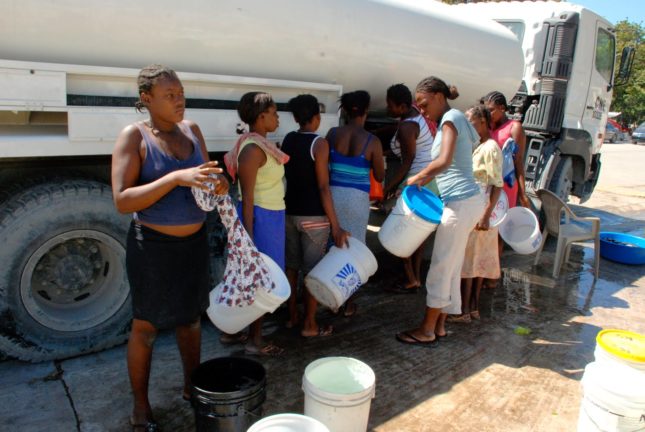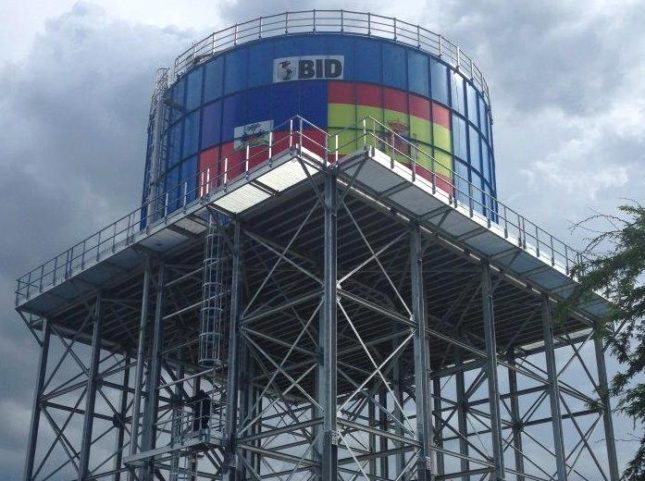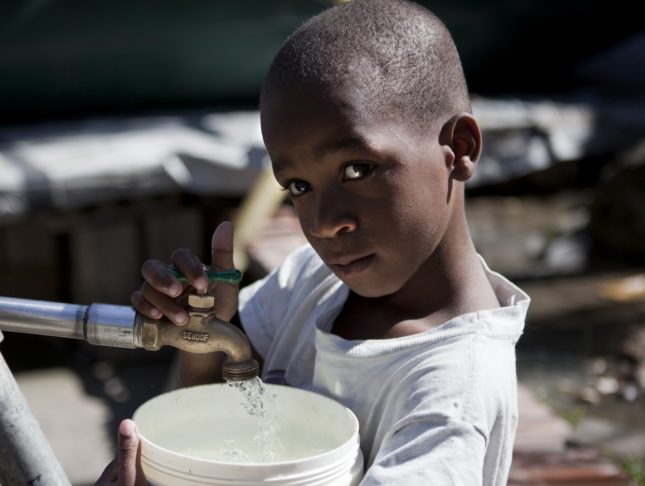
The notion of a colonist as cannibal in Haiti is widespread. This idea, called manje moun (eating people), could hardly qualify as superstition, given the experience of colonialism. It is daunting to find a better description for those who grab control of water and food, and then calculate the minimum caloric intake a population needs so that a maximum of labor may be extracted from its emaciated and zombified workers without killing them. The neo-colonists may call themselves humanitarians, but their victims know exactly what they are.
A Haitian front for a consortium of foreign aid and finance agencies, founded in 2009 and called DINEPA (Direction Nationale de l’Eau Potable et de l’Assainissement, or National Water and Sanitation Authority), has wrested control of all of Haiti’s drinking water from city authorities and non-governmental organizations (NGO). To handle the country’s water rehabilitation and distribution, DINEPA now calls on companies from Haiti’s former colonial masters. These include Spain’s INCATEMA Consulting and Engineering and the world’s top water privatizers, the French corporations Veolia Environnement and Suez Environnement.

Like other corporations, water-privatization companies make money for their investors by increasing their revenues, either by expanding their reach or seeking better prices for their products and services. Both Veolia and Suez reported growths of about 4.6% in the first quarter of 2017, compared to 2016; during the same period in 2017, their revenues were, respectively, a whopping $6.83 billion and $4.12 billion. Before you start to think that water-privatization companies might be a good investment, remember that you, personally, are 70% water and could not live without this liquid for more than three to four days. Consider also that the easiest way to profit from something as naturally plentiful as water is to create a shortage and sell it to the highest bidder. The logical outcomes are thirst, hunger, and water-borne diseases, all of which have already settled on places like Haiti.
While you might be the kind of person who does not give a rat’s ass what happens in Haiti, you are probably not too keen on the idea of having your life ruled by water and paying through your nose for the taste or even the sight of it. What happens in Haiti doesn’t stay in Haiti.
It is a little known fact that Haiti’s cholera epidemic of October 2010 started while the water network for the nearest city of Mirebalais was under repair. Both the water outage and the UN were responsible for the initial explosion of deadly disease, because the water cut-off forced people to collect their drinking water from the very stream that the Nepalese UN troops had contaminated with their untreated wastes. In other words, if Mirebalais’ potable-water system had been working as it should when the UN soldiers contaminated the stream, the casualties from the epidemic would probably have been low to negligible. The incentive to grant contracts to private companies to overhaul Haiti’s municipal water systems would have been trifling too, since there would probably not have been a humanitarian emergency for them to address.

The work of water privatizers in Haiti did not really get the notice of the general public until the protests started in Ouanaminthe in summer 2011. The town had been without water for three months because the service to its center had been cut by INCATEMA. With funds from the Inter-American Development Bank (IDB) and Spain’s aid agency (Agencia Espanola de Cooperacion para el Desarrollo, AECID), in early 2011 DINEPA had contracted INCATEMA to extend Ouanaminthe’s water network by about 20 miles to a slum called Gaillard, where cholera was raging. DINEPA tried to placate the population with promises of a 300,000-gallon water tower and tap water in 6,400 homes in the immediate future, but there was no indication that the service would ever even be restored to its former status. Ouanaminthe had grown from a quiet border town that mostly cultivated peanuts and tobacco, to a so-called free-trade zone, because in the mid-2000s the IDB and Soros Economic Development Fund had financed the construction of an industrial park called CODEVI. In this consortium of sweatshops, six textile companies currently extract the labor of Dominicans and Haitians for about $0.45 per person hour. A network of slums surround the industrial park, which employs only 6,500 people, despite its presence swelling the city’s population more than three-fold, to about 100,000. There has hardly been any new infrastructure to keep up with the rapid rate of growth, and the nearby Massacre River has been polluted by the textile manufacturers: these two factors have created a perfect opportunity to squeeze a population of the poor for their drinking water.
A taste of the money to be made from the sale of water might be all it took to decide that, for privatization to proceed, Haiti’s Constitution would have to go and the government become more centralized. Under cover of carnival, in February 2012, Haiti’s executive branch began, by decree, to dissolve all the local governments and dismiss the country’s elected mayors. The mayors held press conferences to alert the population of their removal and wrote open letters to inform the public about threats to their lives, but, with enforcement from the United Nation’s so-called peacekeeping force, the decree was shoved down Haitians’ throats. By July 2012, nearly all of the country’s departmental delegates (state governors) and 120 elected mayors had been replaced by presidentially appointed Interim Agents, some of whom where actively wanted by police for alleged crimes.
Simultaneously with the decree to remove the mayors, and the continuing cholera epidemic, there began a rash of sabotage of the municipal-water systems. As a result, about 2.5 million residents of Gonaives and Cap Haitien, both large cities that were unaffected by the earthquake, lost their service of piped water. In Cap Haïtien, some pipes under repair were cut and removed in December 2011. Around the same time in Gonaïves, the control panels and electrical cables were yanked from three out of five pumping stations. In another section of Gonaïves, the water pipes were accidentally damaged one year later by construction work. DINEPA, by then, had contracted Veolia to reconstruct the water supplies of cities outside of Port-au-Prince; it announced that it would study the networks of both cities and expand them. To date, there has been no report of the completion of either project.
Haiti’s smaller towns of about 30,000 to 40,000, untouched by the earthquake, were also not spared. In Hinche, the drinking water system was sabotaged at least three times in two years. In the border town of Anse-à-Pitres, several solar panels were removed from a system that had been installed by a local organization. In Belladère, all but two community faucets were damaged by road construction. These are but a few examples.

Ouanaminthe endured three dry years. After that, the angry residents got their water from INCATEMA by confronting the UN troops and blocking, with walls of blazing tires, the streets to the CODEVI industrial park and a binational market. When the Haitian president finally came to inaugurate the supposed $9 million water project in August 2014, it was mainly to inform the townspeople that they would henceforth have to pay for their water. Two years after the inauguration, more than 85% of the homes still lacked water service, and DINEPA was requiring a $54 to $92 deposit, plus a monthly fee of $1.75 for water. People in the area, who earn slave wages in the sweatshops, now complain, not only about the impossibly high costs for them but also the quality of the water, which they say is often covered with yellow foam and reeks of chlorine.
Where did the money go? Given the state of affairs, it is impossible to account for the contributions to DINEPA of more than $75 million from the World Bank, $10-15 million from the UN International Children’s Emergency Fund (UNICEF) per year, $35 million from Spain, and $15 million from the IDB, all for water, sanitation, and the supposed fight against cholera. In my view, much of what has been achieved in Haiti is the dismantlement of the municipal potable-water networks and their replacement with a tanker-truck delivery system. DINEPA appears to have learned that desperately poor people will buy water from its trucks quite expensively, since they get it in smaller volumes. Between 2012 and 2014 alone, the price of a gallon of water, if it could be found, rose by 40%. All over Haiti, a country where water is plentiful, people travel for miles to rivers and water faucets. Some die in traffic accidents collecting their water. Others die from drinking it.
Water-privatization companies, having gorged themselves initially on reconstruction contracts from agencies like the World Bank and IDB in countries like Haiti, have become too strong to control without a Herculean effort. In a Spanish scandal nicknamed “pica en los pies,” which exploded in April 2017, INCATEMA is alleged to have paid bribes for public works contracts in Haiti. Veolia and Suez have both donated money to the Clinton Foundation. In an unprecedented move, a few days before the French second-round presidential elections, Veolia’s CEO endorsed Emmanuel Macron by attacking Marine Le Pen in a published statement. A donation from Suez to US President Donald Trump’s transition team was equally surprising for having a foreign origin. The long and short of it is that fights against water privatizers at the ballot box will probably be futile. In March 2017, Suez began to purchase the Philadelphia-based US utility, GE Water. In December 2016, Veolia took control of Europe’s longest beach, La Baule, in France, to the dismay of much of the population. Water privatizers are unlikely to have a shred of party loyalty or nationalism. They are modern-day vampires, and it is reckless to allow them to wander among us even as they lust after our lifeblood.
(Part 3)
This is the second of a series of articles that examine how water is snatched from cities and privatized. It was originally published on News Junkie Post. Dady Chery is the author of We Have Dared to Be Free.









